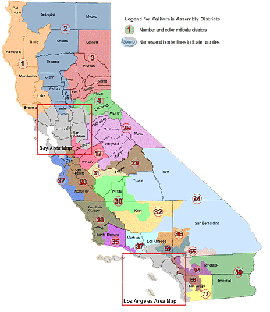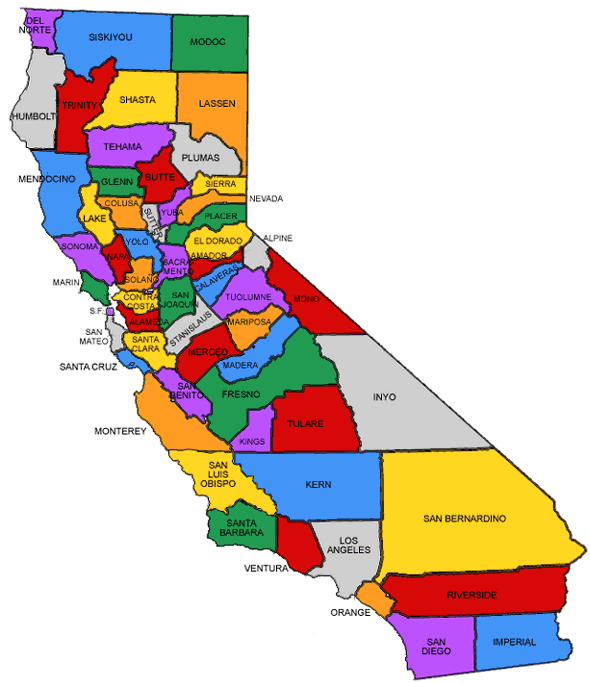
Redistricting in California
California’s redistricting is conducted by an independent commission, rather than the Legislature
By Chris Micheli, July 13, 2020 6:55 am
Every ten years, or once-a-decade, the geographic boundaries of legislative districts are redrawn based upon the results of the United States Census. Redistricting affects the districts for candidates to the State Senate, State Assembly, Board of Equalization, and U.S. House of Representatives. And it is provided for by the California Constitution.
California’s redistricting is conducted by an independent commission, rather than the Legislature, which had done it for decades. The commission and its procedures are set forth in detail in Section 2 of Article 21. The districts in place for 2011 through 2021 were the first that were drawn by the voter-approved commission. These maps can be found on the Commission’s website at www.wedrawthelines.ca.gov.
In 37 states, state legislators are primarily responsible for drawing congressional district lines. But, in California, an independent commission draws both congressional and state legislative district lines. Commissioners must meet the following requirements in order to serve:
- Members must have voted in at least two of the last three statewide elections.
- Members cannot have switched party affiliation for at least five years.
- “Neither commissioners nor immediate family may have been, within 10 years of appointment, a candidate for federal or state office or member of a party central committee; an officer, employee, or paid consultant to a federal or state candidate or party; a registered lobbyist or paid legislative staff; or a donor of more than $2,000 to an elected candidate.”
- Members cannot be “staff, consultants or contractors for state or federal government” while serving as commissioners. The same prohibition applies to the family of commission members.
Once the commission completes its work on the district maps, the must be approved by nine of the 14 Commissioners. These nine must include three Democrats, three Republicans, and three belonging to neither party. There is a process for the maps to be overturned by public referendum.
Article XXI was most recently amended by Proposition 11 on the November 4, 2008 ballot. It contains the following three sections:
Section 1 states that, in the year following the year in which the national census is taken under the direction of Congress at the beginning of each decade, the Citizens Redistricting Commission must adjust the boundary lines of the congressional, State Senatorial, Assembly, and Board of Equalization districts (also known as “redistricting”) in conformance with the standards and process set forth in this article.
Section 2 specifies that the Citizens Redistricting Commission was created no later than December 31 in 2010, and in each year ending in the number zero thereafter. The section provides that the commission must (1) conduct an open and transparent process enabling full public consideration of and comment on the drawing of district lines; (2) draw district lines according to the redistricting criteria specified in this article; and (3) conduct themselves with integrity and fairness. The commission consists of 14 members with specified political party registration and requires each commission member to be a voter who has been continuously registered in California with the same political party or unaffiliated with a political party and who has not changed political party affiliation for five or more years immediately preceding the date of his or her appointment. The commission must establish single-member districts for the Senate, Assembly, Congress, and State Board of Equalization pursuant to a mapping process using the following criteria as set forth in the following order of priority: (1) Districts shall comply with the United States Constitution. Congressional districts shall achieve population equality as nearly as is practicable, and Senatorial, Assembly, and State Board of Equalization districts shall have reasonably equal population with other districts for the same office, except where deviation is required to comply with the federal Voting Rights Act or allowable by law. (2) Districts shall comply with the federal Voting Rights Act (42 U.S.C. Sec. 1971 and following). (3) Districts shall be geographically contiguous. (4) The geographic integrity of any city, county, city and county, local neighborhood, or local community of interest shall be respected in a manner that minimizes their division to the extent possible without violating the requirements of any of the preceding subdivisions. (5) To the extent practicable, and where this does not conflict with the criteria above, districts shall be drawn to encourage geographical compactness such that nearby areas of population are not bypassed for more distant population. (6) To the extent practicable, and where this does not conflict with the criteria above, each Senate district shall be comprised of two whole, complete, and adjacent Assembly districts, and each Board of Equalization district shall be comprised of 10 whole, complete, and adjacent Senate districts.
Section 3 provides that the Redistricting Commission has the sole legal standing to defend any action regarding a certified final map and that it must inform the Legislature if it determines that funds or other resources provided for the operation of the commission are not adequate, in which case the Legislature must provide adequate funding to defend any action regarding a certified map. This section provides that the California Supreme Court has original and exclusive jurisdiction in all proceedings in which a certified final map is challenged or is claimed not to have taken timely effect. Also, any registered voter in this state may file a petition for a writ of mandate or writ of prohibition, within 45 days after the commission has certified a final map to the Secretary of State, to bar the Secretary of State from implementing the plan on the grounds that the filed plan violates this Constitution, the United States Constitution, or any federal or state statute.
- Rights and Duties of Witnesses in Civil Actions - August 21, 2025
- County Powers Over Harbors - August 20, 2025
- Legislative Committees in California - August 19, 2025







